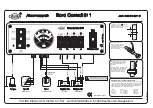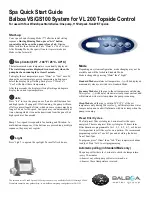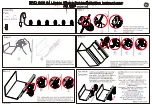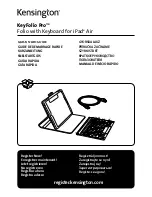
w w w . t e a m n o v a k . c o m
The Rooster 12T has the industry-standard receiver input connector on a
user-replaceable input harness &
works with all major radio brand’s new
receivers
. However, some very old receivers must have the wiring sequence
in the plastic 3-pin connector housing changed.
This is important, because
receiver & servo electronics may be damaged if the sequence is incorrect.
JR • Hitec • Futaba • New KO • Airtronics Z
JR, Hitec, Futaba, new KO, & Airtronics Z receivers do not need input
harness re-wiring.
Airtronics Z receivers have blue plastic cases & new KO
cases have tabs on the input harness openings as in
Figure 1
.
• Plug one end of the input signal harness into the
THROTTLE CHANNEL (#2)
of receiver with the
BLACK wire toward the outside edge
of receiver case.
• Plug the other end of the input harness into 3-pin header on the front edge
of the ESC’s circuit board with the
WHITE wire toward the left side
of the
ESC
(refer to pin-out label on case)
.
Old-style KO • Old-style Sanwa/Airtronics
If you have an older KO or Sanwa/Airtronics, you must change the se-
quence of the ESC’s input harness wires--
Old Sanwa/Airtronics cases are
black color & Old KO cases do not have tab openings, as in
Figure 2
above.
• Using a small flat blade screwdriver,
remove the red & black wires
from the
plastic housing at the receiver end of the input harness as in
Figure 3
below.
•
Interchange the red and black wires
in the plastic 3-pin connector housing
at the receiver end of the input harness.
• Insert modified end of the harness into the
THROTTLE CHANNEL (#2)
of
receiver with the
RED wire toward the outside edge
of receiver case.
• Plug the other end of the input harness into the ESC with the
WHITE wire
toward the ‘S’ (signal) marking
on the ESC’s case.
FIGURE 3
With a small standard screwdriver, gently lift plastic prong until wire
and metal socket easily slide out of plastic housing.
changing wiring sequence
@
receiver end
FIGURE 1
FIGURE 2
New KO
(with tabs)
Old KO
(no tabs)
tabs
no tabs
black
red
red
white
black
white
With ESC connected to (at least) a receiver & a charged battery pack:
1. TURN ON THE TRANSMITTER’S POWER
2. PRESS & HOLD ESC’S ONE-TOUCH/SET BUTTON
3. TURN ON THE SPEED CONTROL’S POWER
With transmitter throttle at neutral, and still
pressing the SET button
,
slide the ESC’s
ON/OFF switch
to ON position
.
4. CONTINUE HOLDING SET BUTTON UNTIL RED LED COMES ON
5. RELEASE SET BUTTON AS SOON AS LED TURNS RED
6. PULL TRANSMITTER THROTTLE TO FULL-ON POSITION
Hold it there until the
green status LED
turns solid green
.
Note: Motor will not run during programming even if connected.
7. PUSH TRANSMITTER THROTTLE TO FULL-BRAKES
Hold it there until the
green status LED
blinks green
.
8. RETURN TRANSMITTER THROTTLE TO NEUTRAL
Red status LED
will
turn solid red
, indicating that speed control is
at neutral and that proper programming has been completed.
NOTE: If transmitter settings are changed, One-Touch Programming must be
repeated. If you experience any problems, turn off ESC & repeat One-Touch.
REMEMBER: Whenever One-Touch set-up is performed, ESC
automatically reverts to Throttle Profile #1.
P2
P3
step
1
–
connect input harness
step 2–
MOUNTiNG ESC
step
4
–
one-touch programming
Be sure to position the ESC with the power wires away from other
electronics & moving parts in the vehicle. Select a location that allows
airflow through heat sinks--
If the ESC gets good air flow, it will run cooler;
and that means it will be more efficient!
1. MOUNT ESC IN THE VEHICLE
using the included double-sided tape
.
Be sure receiver & antenna are mounted as far from ESC, power wires, battery,
& servo as possible--these components all emit RF noise when throttle is applied.
On graphite or aluminum chassis vehicles, it may help to place receiver on
edge with crystal & antenna as far above chassis as possible.
Note: Mount antenna as close to receiver as possible--trail any excess wire off top
of antenna mast (cutting or coiling excess antenna wire will reduce radio range).
2. MOUNT POWER CAPACITOR IN THE VEHICLE
using the included double-
sided tape, or secure it to part of the vehicle with a tie-wrap. The Power
Capacitor can also be tie-wrapped along the battery power wires.
If the Power Capacitor becomes dented or damaged, ESC failure
can occur--replace damaged Power Capacitors immediately.
3. INSTALL ON/OFF SWITCH
using a screw or the included double-sided
tape. Position in the vehicle where it will be easy to access.
If you have any problems with Step 4, adjust transmitter as follows
and then repeat One-Touch programming in Step 4:
A.
Set
HIGH ATV
or
EPA
to
maximum
setting.
[amount of throw at full throttle]
B.
Set
LOW ATV
,
EPA
, or
ATL
to
maximum
setting.
[amount of throw at full brakes]
C.
Set
EXPONENTIAL
to
zero
setting.
[throttle channel linearity]
D.
Set
THROTTLE CHANNEL REV. SWITCH
to
opposite
position.
E.
Set
THROTTLE CHANNEL TRIM
to
middle
setting.
[adjusts neutral position/increases or decreases coast brakes]
F.
Set
ELECTRONIC TRIGGER THROW ADJUSTMENT
to
50%
throttle
and
50% brake
throw
--best for reversible ESCs
.
[adjusts trigger throw electronic/digital pistol-grip transmitters]
G.
Set
MECHANICAL TRIGGER THROW ADJUSTMENT
to position
with
1/2 throttle
and
1/2 brake
throw.
•NOT ALL TRANSMITTERS HA
VE THESE ADJUSTMENTS
•
transmitter adjustments
SET
-UP PHOTO
ON/OFF
switch
Power Capacitor tie-wrapped
along power wires
One-Touch
Set-Up
button
User-replaceable input
signal harness (Ch.2)
Black power wire
(battery negative)
Status LEDs
Trail excess wire off top
of antenna mast
Red power wire
(battery positive)
Blue power wire
(motor negative)
(–)
(+)
4 to 7 cell
battery pack
Yellow power wire
(motor positive)
Tamiya-style
battery connector
Servo
plugged
into
steering
ch. (#1)
12-turn or higher
brush-type motor
The ESC is equipped with
4 user-selectable Throttle Profiles
to choose from:
PROFILE #1:
Forward, brakes, & reverse.
PROFILE #2:
Forward & brakes only.
PROFILE #3:
Forward, brakes, & reverse.
PROFILE #4:
Forward & brakes only.
NOTE:
ESC is factory set to Throttle Profile #1.
selecting throttle profile
:
With ESC on & connected to a charged battery (transmitter ON or OFF):
1. IF TRANSMITTER IS OFF, DISCONNECT ESC FROM RECEIVER
To avoid possible radio interference from other transmitters, remove
the ESC’s input signal harness from the receiver.
2. PRESS & HOLD THE ESC’S ONE-TOUCH SET BUTTON
Continue to hold SET button
on ESC
until both LEDs turn on
.
3. RELEASE SET BUTTON AS SOON AS BOTH LEDs COME ON
Once released, the 4 status LEDs will flash to indicate what Throttle
Profile is currently selected
. The number of times the LEDs flash
indicates the Throttle Profile selection
(1 of 4)
.
4. QUICK PRESS
(& release)
SET BUTTON TO CHANGE SELECTION
Each press will change to the next consecutive Throttle Profile.
*** Note: there is a time constraint during this selection process. ***
5. ESC STORES SELECTION & EXITS TO NEUTRAL
If SET button is not pressed for 3 seconds,
ESC stores selected Profile
into memory & the red LED will come on solid. The speed control
is at neutral & is ready to go.
NOTE: Whenever One-Touch set-up is performed, ESC reverts to Throttle Profile #1.
throttle profile selection
step 3–
motor & battEry cONNEctiON
1. MOTOR CAPACITORS
Electric motors generate RF noise that causes interference. The included
0.1µF (50V) non-polarized, ceramic capacitors must be used on all motors
to reduce motor noise & prevent ESC damage.
Note: Some motors come with capacitors built-in. If your motor
only has two capacitors, you need to install a capacitor between the
positive & negative motor tabs––If you experience radio interference
when using only built-in capacitors, install external ones.
Solder 0.1µF (50V) capacitors between:
• POSITIVE (+) motor tab & NEGATIVE (–) motor tab.
• POSITIVE (+) motor tab & GROUND tab*.
• NEGATIVE (–) motor tab & GROUND tab*.
*If motor has no ground tab (below), solder the capacitors to motor can.
Negative (–) motor tab
**NO SCHOTTKY DIODE**
0.1µF Capacitors
Positive (+) motor tab
Ground / motor can
Extra 0.1µF capacitors are available in Novak kit #5620.
2.
DO NOT USE SCHOTTKY DIODES
Schottky diodes must NOT be used with reversible ESCs (including
brushless). Schottky diode usage will damage the ESC & void warranty.
If you are going to use connectors on the ESC’s motor wires, we highly
suggest Dean’s Ultra plugs or other low-loss connectors--do not use
crimp type connectors.
Note: If you plan to change the battery connector,
be aware that this can void the warranty if not done properly.
To prevent possible cross-connection of motor and battery wires:
• Use connectors that cannot be plugged in backwards. Reverse voltage
will damage the ESC and void warranty.
• Use a female connector on battery packs to avoid shorting.
For additional information on connector usage, visit our website.
connector usage
3. FACTORY-INSTALLED POWER CAPACITOR REQUIRED
The ESC comes with a factory-installed Power Capacitor, and it MUST
be used for proper operation and protection.
If Power Cap. becomes dented or damaged, ESC failure can occur
--replace immediately
.
Longer Power Capacitor wires will decrease performance
.
4. SOLDER MOTOR POWER WIRES TO MOTOR
a.
Cut the ESC’s
BLUE & YELLOW
silicone motor power wires to the
desired length, and strip 1/8-1/4” of insulation from the end of each
wire. Tightly twist the exposed strands of wire.
b.
Solder the ESC’s
BLUE
motor wire to the
motor’s negative (–) tab
.
c.
Solder the ESC’s
YELLOW
motor wire to the
motor’s positive (+) tab
.
6. CONNECT SPEED CONTROL TO BATTERY PACK
Connect the ESC’s Tamiya-style JST battery connector to a charged 4
to 7 cell
(1.2VDC/cell)
battery pack (or 2-cell Li-Po pack). Connector
can also be changed to a different type, or ESC can be hard-soldered
directly to battery pack.
FIGURE 4
using a receiver battery pack
Your new speed control has a built-in BEC (battery eliminator circuit), and you do
not need to use a separate receiver battery pack, however if you are planning to use
one to power the electronics you need to do the following:
1.
Plug the external 5 cell (1.2VDC/cell) receiver battery pack into the battery
slot of the receiver.
2.
Leave the
ESC’s ON/OFF switch
in the
OFF
position, and
use receiver battery
pack’s ON/OFF switch
to turn the
system power on and off
––Do not use the
ESC’s switch.
Li-Po Cut-Off Circuitry Active
Ni-Cd & Ni-MH cells ONLY




















